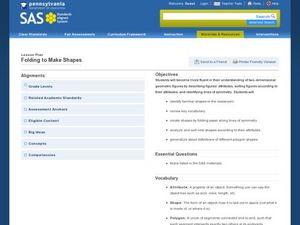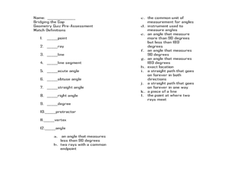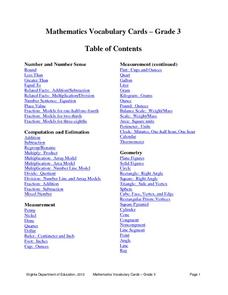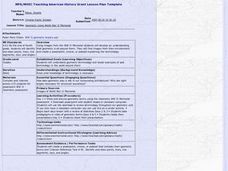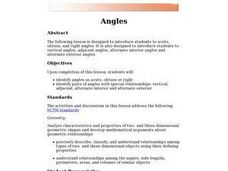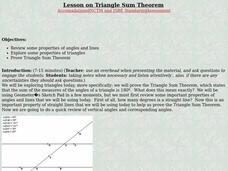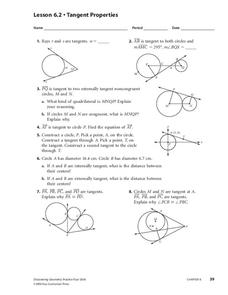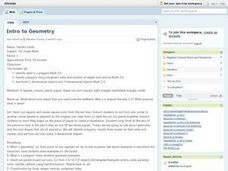Curated OER
Folding to Make Shapes
Second graders identify different polygons and their attributes. In this geometry lesson, 2nd graders get to know polygons by studying the vocabulary and finding polygons in their classroom. They create these shapes and then find their...
Curated OER
Geometry Definitions
In this geometry learning exercise, learners match the geometry term with its definition. Students match 12 geometry terms with their definitions.
Curated OER
Reflection and Refraction
Life is only a reflection of what we allow ourselves to see. The lesson includes three experiments on light reflection, light refraction, projection, lenses, and optical systems. Each experiment builds off the ones before and...
Curated OER
Angle Exploration and Classification
Students compare and contrast angles and identify them as acute, obtuse, right, or straight angles. They create rays and angles using uncooked spaghetti, read and discuss key vocabulary terms, and complete a variety of geometry worksheets.
Mathematics Vision Project
Module 2: Congruence, Construction and Proof
Construct yourself a winning geometry unit. A set of lessons introduces geometry scholars to constructions and proofs with compasses and straightedges. It also covers triangle congruence through transformations. This is the second of...
Virginia Department of Education
Mathematics Vocabulary Cards - Grade 3
Need to go over some math concepts with your third graders? Use a series of math posters, featuring vocabulary words in geometry, measurement, fractions, probability, and many other areas of study. Each poster presents the term with an...
Curated OER
Exploring Geometric Patterns and Relationships
Sixth graders explore different geographic relationships in like drawing lines, rays, and parallelograms. This lesson could be used for review because it covers more than one concept. The students should have prior knowledge.
Curated OER
Geometry of The World War II Memorial
Students develop an appreciation of the use of geometry in our everyday world and structures. Students collect various picures and multimedia objcets that explain geometric principles and place them in a powerpoint presentation to be...
Curated OER
Geometry, Word Search Puzzle
In this math worksheet, students look for the words that are related to the math words used in the practice of geometry. They also practice spelling.
Curated OER
The Right Angle
In this geometry worksheet, 10th graders determine the answer to a vocabulary questions and then follow the give rules to place the answer in the appropriate place on the crossword grid. The one page worksheet contains 18...
Curated OER
2-D Geometry
Third graders describe and compare attributes of two-dimensional shapes. They explain geometric terms, angles and shapes. Students demonstrate each vocabulary word with their body and they mirror the body positions associated with each...
Curated OER
Geometric Angles
Students explore angles and their use in Geometry. Students investigate three different kinds of angles: obtuse, acute, and right angles through an online activity. They identify pairs of angles with special relationships: vertical,...
Curated OER
Shapes from Shapes
Geometric shapes are really cool. Examine triangles, quadrilaterals, trapezoids, rhombuses, parallelograms, pentagons, and hexagons with your class. They draw large shapes and small shapes then compare them to understand their shapely...
Curated OER
Why do Stars Rise in the East?
In this stars rise in the east worksheet, students use geometry to show how the Earth rotates from west to east and why celestial bodies appear to rise in the east and set in the west. Students draw a figure and label given points in...
Ohio Department of Education
I Can Name that Angle in One Measure! - Grade Eight
Collaborative groups work with geometry manipulatives to investigate conjectures about angles. They create a graphic organizer to use in summarizing relationships among angles in intersecting, perpendicular and parallel lines cut by a...
Curated OER
Positive and Negative Angles and Arcs
To better understand that the intersection point of two lines lies inside a circle, learners use their keen measurement skills. They discuss arcs, rays, tangent lines, and reflex angles. Then, they put their skills to work as they...
Curated OER
Constructing Perpendicular Bisectors
Tenth graders investigate parallel lines and the angles formed when cut by a transversal. For this geometry lesson, 10th graders construct perpendicular lines and discuss midpoint, segments and perpendicular bisectors. They relate...
Curated OER
Tangent Properties
In this pre-calculus worksheet, students solve for angles formed by a tangent line and a circle. There are 6 different worksheets containing 8-10 problems per sheet.
Curated OER
Triangle Sum Theorem
Tenth graders investigate the theorems of angles and lines to prove triagle sum theorem. In this geometry lesson, 10th graders discuss the theorems of triangles and how it is used to solve for missing sides or angles. They review how two...
Curated OER
Corresponding Sides and Angles of Similar Triangles
Students differentiate between corresponding sides ad angles of two triangles. In this geometry lesson, students identify the differences as well as the similarities between two triangles. They differentiate between similar and...
Curated OER
SAS Similarity Theorem
Students identify and use the similarity theorem. In this geometry lesson, students differentiate between congruent and similar triangles. They solve problems using the computer modifying shapes by dragging.
Curated OER
Tangent Properties
In this geometry worksheet, 10th graders solve problems based on the properties of lines tangent to one or more circles. Constructions are included. The one page worksheet contains eight questions. Answers are...
K12 Reader
Kinds of Angles
Have you ever wondered how circles and angles relate to each other? Read a passage about right angles, acute angles, and obtuse angles, and answer reading comprehension questions about the information you learn.
Curated OER
Intro to Geometry
Seventh graders identify a polygon and classify them using congruent sides and number of edges and vertices. Students transform two dimensional objects into three dimensional objects.


